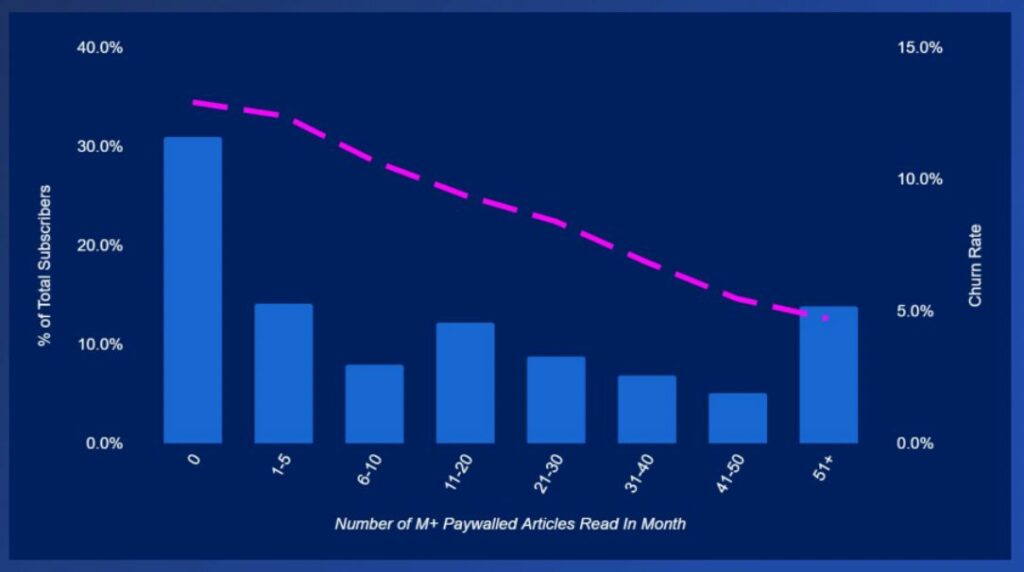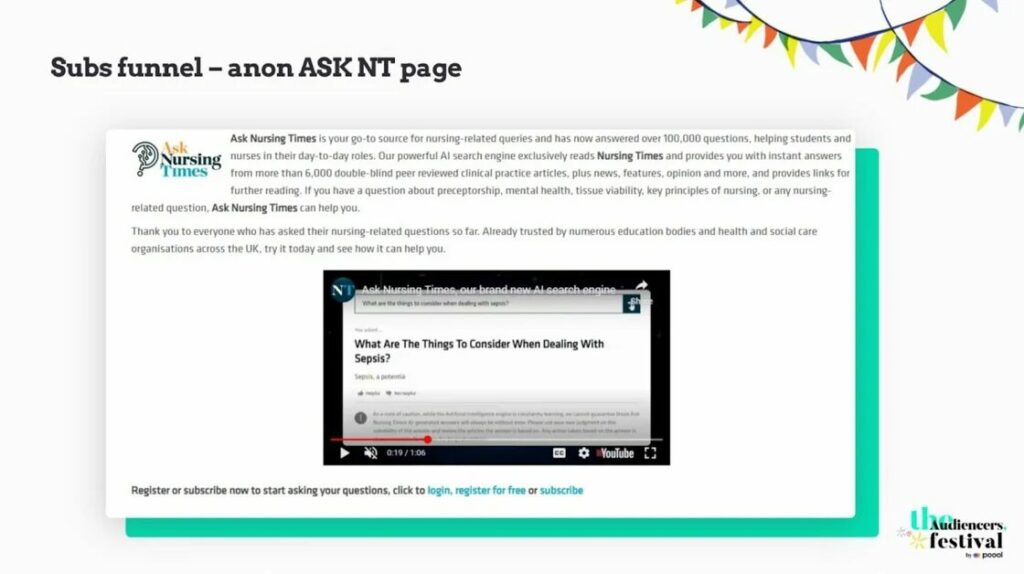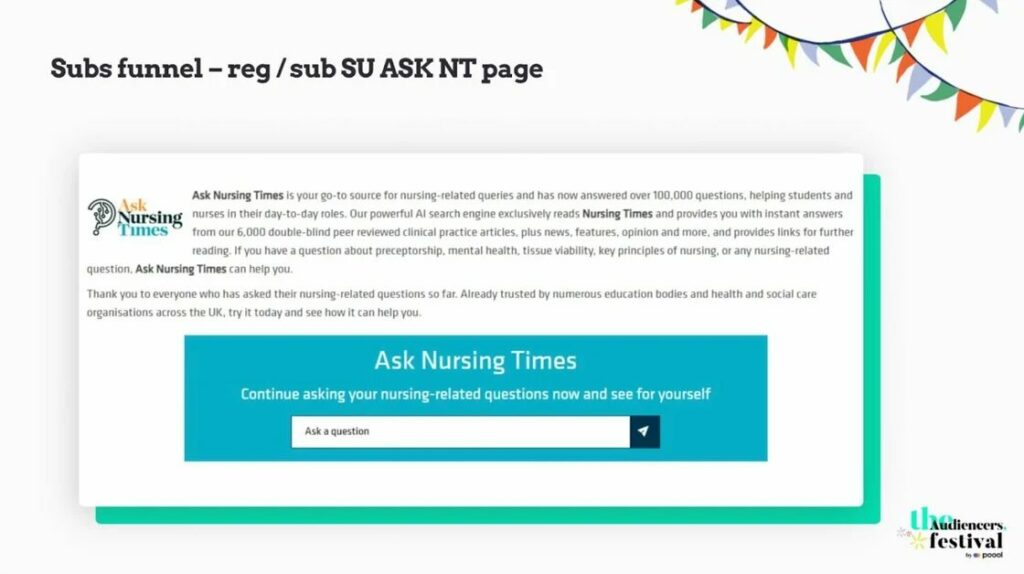

You're reading The Audiencers' newsletter #67 sent out on July 9th, 2025. To receive future newsletters straight to your inbox every two weeks, sign up here.
Today’s newsletter is a Festival special, with key takeaways from London’s hugely successful event! Thank you to everyone who attended, to our brilliant speakers (genuinely blown away by the quality of this year’s sessions), our sponsors (code.store, Chargebee & WordPress VIP) and all of you, for being part of this growing community – we couldn’t do what we do without you!

In today’s newsletter:
- Defining the ideal subscriber to Mail+, Andy Wilson shares his work on retention at Daily Mail
- How Business Insider saved more subscribers… by making it easy to cancel!
- Nursing Times’ premium experiences with AI
- 🔗 Links links links – to add to your reading list
Defining the ideal subscriber to Mail+
At our Workshop in London, Andy Wilson, Head of Subscriber Retention, shared some of the various tests they’ve run to improve retention for their subscription offer, launched early last year.
As Andy highlighted, the most valuable work they’ve done is to define “The ideal subscriber”. The question was ‘if we want our subscribers to complete a handful of actions, what would they be?’
For instance, they found that the more devices a subscriber used, the more likely they are to be highly engaged.


They then correlated this with churn, finding that the more platforms a subscriber engages with, the less they churn
For instance, if they moved a subscriber from using 1 platform, to 3, they could expect a 56% decrease in churn.
Research also showed that increasing the number of Mail+ articles read from 1 per week, to 1 per day yields a 61% improvement in churn.

What they did with this information:
> Relaunched onboarding to focus on these elements that drive engagement.
> Fewer CTAs that were easy to find, enticing and focused
> Onboarding on day 0 and 1 of a subscription, when the customer is most engaged
> Easy-to-understand key targets defined for internal teams around “The ideal subscriber”
How Business Insider saved more subscribers by making it easy to cancel
Sabrina Cesar Tolomei, Senior Product Manager, Subscriber Retention, described how BI initially had a difficult online cancellation process, leading subscribers to call to cancel and deterring resubscription.
The solution:
> They created their own account management and cancellation flow, making it easier to find the cancel button and incorporating a survey to understand reasons for cancellation.
> A “Fear of Missing Out” page and save offer page with a single discounted price.

The results: This led to immediate wins, such as 50% decrease in email customer inquiries and an average 6% save rate.
Going further: To increase Lifetime Value (LTV), they started A/B testing different save offer pricing based on subscriber attributes like current price paid and tenure. This led to the development of a “Save Offer Manager,” an interface allowing them to create rules for dynamic pricing based on criteria like currency, cadence, and tenure.

The results
Results showed the average save offer rate nearly doubled, increasing annual subscriber save rates and overall LTV.
Nursing Times’ premium experiences with AI
Robin Booth, Managing Director at Nursing Times, shared a powerful message that they’re practicing at NT: if publishers want to own the customer relationship in the AI era, it’s time to offer premium content coupled with premium experiences.
But if we’ve learnt anything from the media industry’s AI tests until now, it’s that we need to start with the problem, not with AI.
The problem: Existing site search provided a poor user experience, but had potential to support Nursing Times’ mission of informing readers with quality, reliable information.
The solution: Ask Nursing Times, an LLM search service launched in February 2024, giving instant answers exclusively from NT’s trusted content, with references and links back to the original articles. It also offered AI-generated related questions to encourage deeper exploration, presenting content in a far more engaging and useful way than traditional search.
Key decisions underpinning ASK Nursing Times:
- Buy, not build: Speed was paramount. They partnered with Miso, an LLM search specialist, rather than trying to build in-house expertise from scratch.
- Walled garden: Crucially, they opted for a private AI model, ensuring answers were accurate, from a single trusted source, and that content wouldn’t train external LLMs.
- Tiered access: A strategic move to drive conversions. Anonymous users get answers to AI-generated questions, but subscribers get unlimited access to ask their own questions, with free trial users getting a limited quota.


- Hybrid approach: They kept traditional search alongside the LLM, acknowledging users might not be ready for a forced switch.
The results
Since launching, they have generated over 200,000 AI-powered answers, with a strong 5-6% click-through rate and a 6-percentage point increase in subscriber engagement. They’ve also directly acquired over 100 new subscribers from ASK links, proving AI-powered experiences can indeed generate new revenue.
> Full recap on The Audiencers here
Recommendations to add to your reading list
- From Markus Schöberl, The Big Mac Index: a tool for comparing subscription price across the media industry
- On a similar topic: 2025 European Digital News Pricing Report “We’ve mapped pricing, discounting, and trial strategies from 101 European newsrooms. If you’re planning to launch or rethink your digital subscription model this year, this is for you.”
- From Mili Semlani: We exchanged notes on community building for journalism. Here are some key insights
See you in two weeks for the next newsletter,
Madeleine


